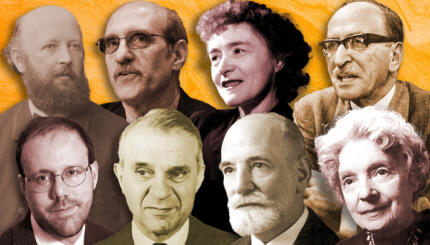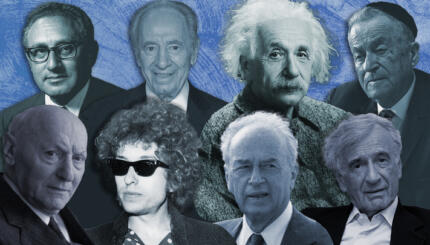The Cold War struggle to allow Jews to leave the Soviet Union was not only fought from behind the Iron Curtain. The powerful grassroots advocacy movement that emerged in America played a critical role in securing the release of Soviet Jewry. In the process, it helped shape the political contours of the American Jewish community.
First Advocacy Groups
The first American advocacy groups for Soviet Jewry were founded in 1964. That year, the Cleveland Committee on Soviet Anti-Semitism was started by a group of local Jews and a student organization. Student Struggle for Soviet Jewry was established in New York City by British expatriate Jacob Birnbaum, who saw the group as a way to revive Jewish life for young people. Both of these groups were far outside the Jewish establishment. In the early 1960s, the American Jewish community was increasingly prosperous and assimilated. In many ways, the Soviet Jewry movement was a form of resistance to what was perceived as a culture of complacency among the Jewish community and particularly its leadership.
In fact, when establishment leaders tried to organize around the issue of Soviet Jewry, they were largely unsuccessful. In April 1964, representatives of most of the major Jewish organizations in America met in Washington for the American Jewish Conference on Soviet Jewry. But, in the end, the conference was little more than a symbolic gesture, and it was adjourned without providing a budget or staff for any kind of sustainable program. The issues of concern–the Soviet suppression of Jewish life and the barring of most emigration–were wholly neglected.
This spurred the two grassroots groups to further action. The small Cleveland group, led by Lou Rosenblum, a local NASA scientist, eventually joined forces with newer groups all over the country and formed the Union of Councils on Soviet Jewry. They busied themselves making contacts with Jewish activists in the Soviet Union and led local protests, trying to make the issue as visible as possible.
By the end of the 1960s, there was also a more militant force in the struggle: Meir Kahane and his Jewish Defense League. Founded in 1968, the JDL made front-page headlines when they started their publicity-catching and often violent actions on behalf of Soviet Jewry. After gaining much attention with a string of bombings in 1970 and ’71 of New York buildings like the Soviet mission to the UN, they eventually fizzled out when one of their explosions killed a Jewish secretary working in the offices of Sol Hurok, an impresario who brought over acts from the Soviet Union.
Both Kahane’s violent shenanigans and the Student SSSJ’s non-violent protest marches and vigils would have amounted to little without a series of blunders by the Soviet Union itself. First, in 1970, Soviet authorities arrested a group of Jews in Leningrad who were attempting to steal a plane and fly it out of the Soviet Union. After a dramatic trial, they sentenced two of the hijackers to death–a sentence that was subsequently commuted because of world outcry. Then in 1972, with immigration beginning to increase, partly as a response to the protests of the Leningrad hijacking, the Soviets decided to implement a diploma tax, charging any Jew who emigrated an exorbitant fee, perceived as a kind of ransom charge, in order to pay back the Soviet education he had received.
The Jewish Establishment

These two events inspired the grassroots groups to increase their activities and pushed the Jewish establishment to properly address the issue. Following the Leningrad trial, a fully funded national organization, the National Conference on Soviet Jewry, was started by a coalition of prominent Jewish organizations to coordinate the Jewish community’s response.
The answer to the diploma tax was even more dramatic. At the time President Richard Nixon and Henry Kissinger, the key architect of his foreign policy, were engaged in a process of détente with the Soviet Union. At the center of the process was a large trade bill that would give the Soviets what their suffering economy desired, Most Favored Nation trading status. As a result of the imposing Soviet diploma tax, Senator Henry Jackson from Washington, a Democrat and fierce Cold Warrior, introduced an amendment to the trade bill that would demand the Soviets let a certain number of Jews immigrate if the country wanted the coveted trading status. The Jewish community got behind the amendment, which became known as the Jackson-Vanik amendment, in a legislative battle that lasted three years. It was the strongest exercise of political power by the Jewish community this far. And, to some extent, it worked. Though the trade bill collapsed — the Soviets, deeply offended, walked away from it — the end of the 1970s saw record numbers of Soviet Jews emigrating.
The 1970s also saw a convergence of the grassroots and establishment parts of the movement. They both staged large protests separately and together, with the establishment-sponsored annual Solidarity Sunday marches in New York frequently drawing more than 100,000 people. And both championed specific Soviet Jewish activists or Refuseniks (the term was used to describe those who had applied for exit visas and were refused) who had been persecuted above and beyond the normal loss of their jobs, known sometimes as Prisoners of Zion. The most famous of these was Anatoly Sharansky, a young, charismatic activist whose excellent English had turned him into a crucial link with Western visitors and journalists. He was arrested, accused of being a CIA agent, and, in 1978, was sentenced to 13 years in forced labor camps. By the end of the decade he was a household name in America.
In 1975, the Soviet Union signed the Helsinki Final Act, an accord with the West that legitimized the Soviet’s World War II territorial acquisitions. In exchange, the Soviets had to sign on to an extensive set of human rights obligations. By agreeing to these, the Soviets had handed both dissidents in their own empire and activists in the rest of the world a potent tool. Subsequent conferences to monitor adherence to the pact, in Belgrade in 1977 and Madrid from 1980 to 1983, became international forums for publicizing the cause of specific Refuseniks and translating the issue of Soviet Jewry into the new and resonant language of human rights.
But because American Jews had effectively linked Soviet Jewry to Cold War diplomacy, when relations between the superpowers went into deep freeze in 1980, mostly due to the Soviet invasion of Afghanistan, emigration came to a standstill. Whereas 1979 had seen over 50,000 Jews leave the Soviet Union, only a couple thousand were given permission the following year. The American movement, composed of many people who had been active for over a decade, also suffered a kind of depression at this point. The movement for Soviet Jewry had become institutionalized, with a set program of protests and standard local activities like a twinning programs that paired bar and bat mitzvahs with Soviet Jewish children their age. This normalization of the cause led to a kind of stagnation, not helped by the fact that numbers kept declining and no big victories seemed to be on the horizon.
Human Rights as Foreign Policy
This began to change with Mikhail Gorbachev’s ascension to power in 1985 after a half-decade of extremist and geriatric Soviet leaders. Though emigration hit a new low of just 500 the year he took power, his language of openness was promising. The leadership in Washington was also particularly committed to the cause. Though Jimmy Carter introduced human rights as a foreign policy issue, Ronald Reagan took enforcement of these rights very seriously, especially when it came to Communist countries. From his first summit meetings with Gorbachev, he arrived with lists of longtime Refuseniks and Prisoners of Zion that he wanted released. Reagan and his Secretary of State, George Schultz, also worked very closely with the Soviet Jewry establishment. By 1986, Shcharansky had been released early from labor camp and allowed to leave the Soviet Union, and it seemed the tide was shifting.
The Soviet Jewry movement, which had started in the early 1960s with a handful of students and outsiders, was by now a central issue in American Jewish life. Through their persistent advocacy and lobbying, the Jewish community also learned something about how to flex its political muscle. The Soviet Jewry movement strengthened Jewish identity and bridged the right-left divide that split most Jews when it came to discussions of Israel. Whether out of human rights concerns or because of more Jewishly centered ones, Soviet Jewry was an issue that united Jews in America.
This unity was most evident in December 1987 when Gorbachev made his first visit to Washington. Over 250,000 people gathered in front of the White House to protest on behalf of Soviet Jews, the largest gathering ever for a Jewish cause. The event was also a celebration, with Sharansky and many other famous prisoners present. It was clear that, though the numbers of emigrants were still low, that the movement was achieving its goals. The next day, Reagan pointed out to Gorbachev how large and vociferous the rally had been. Within the next three years, the floodgates opened. With the arrival of hundreds of thousands of Jews in Israel and in America, the movement could claim what few social movements ever can, that it had unequivocally achieved its goal.
For more information, including primary, historical documents, visit the Archive of the American Soviet Jewry Movement at the American Jewish Historical Society.
Torah
Pronunced: TORE-uh, Origin: Hebrew, the Five Books of Moses.



